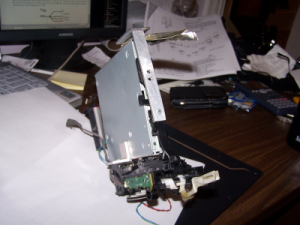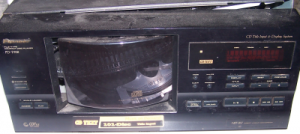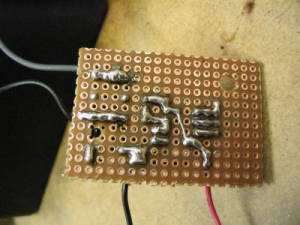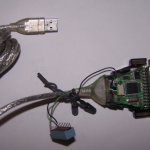The Loading Lever
 I designed a replacement loading lever using my academic copy of Solid Edge v11. It almost mirrors the original, except, because I no longer use the upper lever also, there can be a bit more material. This will be made out of aluminum to improve rigidity also.
I designed a replacement loading lever using my academic copy of Solid Edge v11. It almost mirrors the original, except, because I no longer use the upper lever also, there can be a bit more material. This will be made out of aluminum to improve rigidity also.
The data CD/DVD jukebox
I was always fascinated with those large cd changers when they were new; but, they were always expensive. Plus, with no more than 50 to 100 audio CDs, they aren’t that useful to me – it’s much easier to carry around compressed copies. I had seen SCSI 4×4 disc changes in standard 5.25″ form-factor, and had seen tape drive autoloaders as well. I ended up getting a line on a non-working 101 audio disc changer. I could now build a prototype.
When I first envisioned this project, hard disk storage was still relatively expensive; I had 20Gb and 30Gb drives, the later had just been purchase at a cost of over $300CAD. Compare this to buying good quality CD-R discs in bulk at $0.15/ea. Hard drive storage was running ~$10/GB, while CD-R storage was ~$0.22/GB – not accounting for the cost of a CDR drive, or considering the relative frailty of the media.
The obvious main difference between the storage schemes boiled down to access speed, latency, write speed, media handling, and the amount of data you can have online at a time. I didn’t want to have to handle CD-R discs, risking damage, and, I didn’t want to have to swap them in or out often. While filesystems such as mediadatabase or hierachical storage file system exist, and could be used (or modified) to run an active filesystem on such a device, the extreme latency, low access speeds, and small capacity of single discs make this a less than perfect option. However, a device such as this is well suited as an automated backup system – the 101 disc change would hold 70.7GB on CDR before compression. The option to simply upgrade the unit to a DVD-R (or dual layer) drive when cost effective would further expand the backup capacity to 474GB (or 949GB)! Needless to say, years after the initial idea, I was still thrilled to redesign the disc changer robotics to accommodate a highspeed data drive and computer control.
For the prototype, I used the CDRom drive from an old-style slot loading iMac – slimline drives were much easier to mount to the jukebox. The only change to the drive was an external connection to the “disc inserted” sensor, allowing loading to be triggered at will — using an external sensor, this allows loading discs from wider aproach angles. This can be triggered through the jukebox’s own loading mechanism when it goes to load a disc.
At this point, I have temporarily stopped work on the control system, after dropping the new drive mechanism, breaking a critical part. I will machine (or scrounge) a replacement eventually.






 I’ve never been a morning person. But, I’ve found the best way to wake up is with natural light. These indoor solar simulators hold no candle to the bright sunlight on a clear morning. My solution was an alarm clock to draw back the curtains.
I’ve never been a morning person. But, I’ve found the best way to wake up is with natural light. These indoor solar simulators hold no candle to the bright sunlight on a clear morning. My solution was an alarm clock to draw back the curtains.






 I designed a replacement loading lever using my academic copy of Solid Edge v11. It almost mirrors the original, except, because I no longer use the upper lever also, there can be a bit more material. This will be made out of aluminum to improve rigidity also.
I designed a replacement loading lever using my academic copy of Solid Edge v11. It almost mirrors the original, except, because I no longer use the upper lever also, there can be a bit more material. This will be made out of aluminum to improve rigidity also.





 The NEC MobilePro 900. A beautifully sized and featured Handheld PC circa 2003. A venerable performance beast when compared to its earlier brethern – although doomed to run WinCE out of the box. This thing packs a 400MHz Intel PXA255, 64MB RAM, 32+32MB flash, touchscreen, unimpressive although adequate 8.1″ DSTN HVGA display, PCMCIA and CF slots, USB host port and built-in modem into an extremely portable ~ 9.7″x5″x1.2″ package. Plus, it sells used for less than it’s earlier siblings for which linux ports exist, and boasts a 10 hour battery life und
The NEC MobilePro 900. A beautifully sized and featured Handheld PC circa 2003. A venerable performance beast when compared to its earlier brethern – although doomed to run WinCE out of the box. This thing packs a 400MHz Intel PXA255, 64MB RAM, 32+32MB flash, touchscreen, unimpressive although adequate 8.1″ DSTN HVGA display, PCMCIA and CF slots, USB host port and built-in modem into an extremely portable ~ 9.7″x5″x1.2″ package. Plus, it sells used for less than it’s earlier siblings for which linux ports exist, and boasts a 10 hour battery life und er standard productivity.
er standard productivity. USB to 25-pin parallel “file transfer cable.” I saw someone tossing this out, and through the transparent shell, I could see too many components for a simple USB bridge chip. Conveniently, the IO is broken out for you, power supplied though USB and, it has a USB interface for your new age convenience. Because the software is stored in an external EEPROM, it’s simple to invoke the built in development bootloader — ground the SCL pin (I added a switch) to bypass the external software. Now, if you want to read or reprogram the EEPROM, just flip the switch back.
USB to 25-pin parallel “file transfer cable.” I saw someone tossing this out, and through the transparent shell, I could see too many components for a simple USB bridge chip. Conveniently, the IO is broken out for you, power supplied though USB and, it has a USB interface for your new age convenience. Because the software is stored in an external EEPROM, it’s simple to invoke the built in development bootloader — ground the SCL pin (I added a switch) to bypass the external software. Now, if you want to read or reprogram the EEPROM, just flip the switch back.